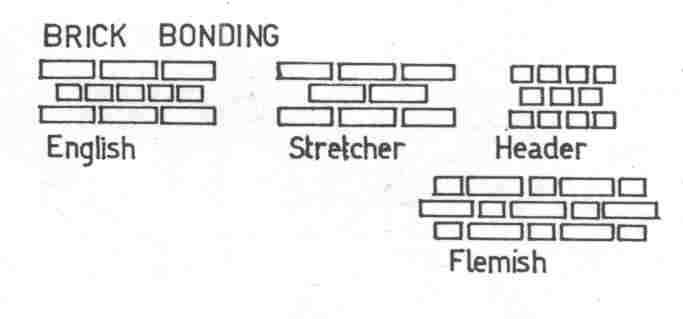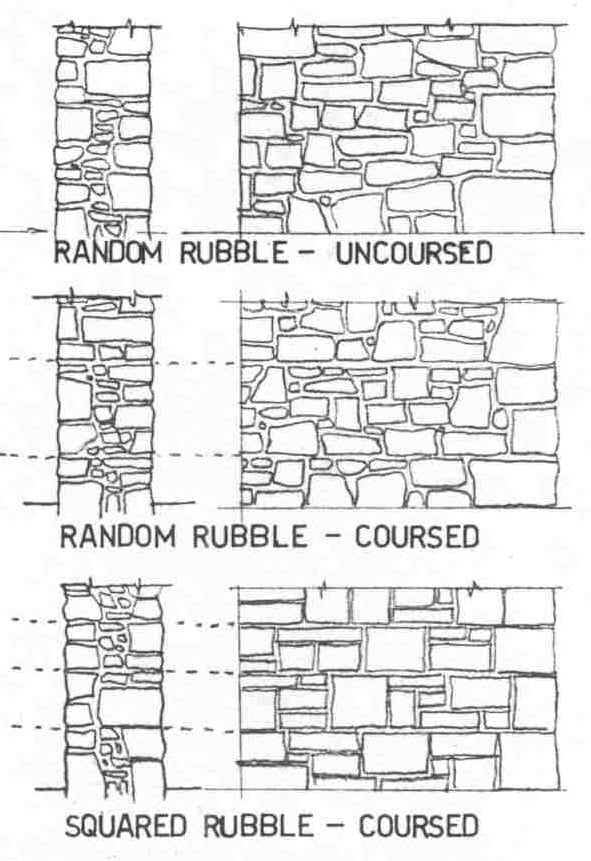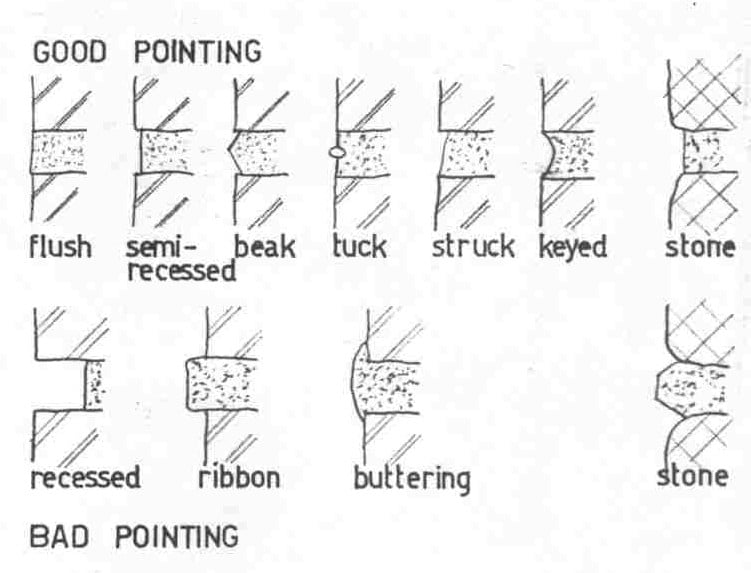BRICKS
Bricks were introduced to this country by the Romans and have been in general use since the thirteenth century. They have been made in many shapes, sizes, colours and textures, and consist of clay, concrete or calcium silicate, each having its own characteristics. The bricks on listed buildings will invariably be clay and other types of brick would not normally be suitable for works of restoration, alteration or extension.
It is important to note the characteristics of the brickwork on an individual building, and these will vary considerably. Most bricks were made locally, and are often specific to a small area.
The appearance of brickwork is also a result of the bonding, decorative details, and the type of mortar used.
HEADERS
Many bonds make use of brick headers (end on bricks). These are sometimes full size bricks through the wall or may be ‘snap headers’ (half bricks) in the case of cavity wall construction.
In many cases these headers are of a blue/grey vitrified appearance. They were used for their decorative effect and are very difficult to replace or to match. Every effort should therefore be made to retain or salvage such bricks where they occur.
GAUGED BRICKWORK
In some cases rubbed bricks of smooth appearance with fine joints may be found, often used for decorative details such as window or door arches. These are an important part of the buildings character and should be retained.

STONE
The most common types of stone found on the Island are the greensands from the Atherfield beds and the central area, Bembridge limestones and chalk, and the sandstones stained with iron that characterise the Brighstone and Shorwell areas. None of these stones are particularly hard and they are prone to weathering and erosion. It is important that new or reclaimed stone is a good match for the original where replacement or extension is to be considered. The methods of laying and dressing the stones also vary and should be respected. Some examples are illustrated.
Corners and openings in stone walls are often reinforced either with large dressed stones or by the use of brickwork and again it is important to reflect the existing character of the building where alterations or repairs are proposed.
Old stone walls - especially in random or coursed rubble are notoriously difficult to alter and if parts have to be removed, there is a tendency for larger areas of the wall to crumble. This is due to the loose nature of the fill in the centre of these walls and the soft, often decayed, state of the mortar. Great care should be taken when working on such walls.

MORTAR
Mortars are made up of various constituents, generally lime, sand and cement mixed in different proportions with water. Occasionally other aggregates such as crushed stone or brick were used and this obviously affects the colour and texture of the finished mortar.
On most older buildings lime based mortars were used and although these take longer to set, they have the advantage of greater flexibility and porosity than the stronger cement mortars.
POINTING
When re-pointing, it is essential that the mortar mix should not be stronger than the bricks or stones. This would result in moisture retention, frost damage, cracking and spalling of the face of bricks or stones.
Lime based mortars should be used for re-pointing and the colour and finish should match the original as nearly as possible.
Colour and texture of the mortar are controlled by the constituents (particularly the sand) and occasionally by the use of coloured additives, as well as by the profile of the joint.
The importance or pointing on the appearance and durability of the wall should not be underestimated as the effect of an error can be disastrous and irreversible. It is a job which requires skill and experience and should be entrusted to a skilled craftsperson.
Pointing can take many forms, but those with recessed or protruding joints should be avoided. They allow water to penetrate the masonry and lead to early decay. Their appearance is generally not compatible with traditional masonry.
Tuck pointing was a device used to produce the appearance of fine mortar joints in traditional brickwork. Mortar of the same colour as the bricks was used and flush jointed. A fine straight line was formed and filled with white lime putty to simulate rubbed and gauged brickwork . Examples are not very common and should be retained and restored wherever possible
 Maintenance and treatment of stone and brickwork
Maintenance and treatment of stone and brickwork
Simple water washing is always the best method of cleaning, and is best carried out by specialists. The use of sandblasting or chemicals removes part of the surface material and should only be carried out in extreme cases with specialist supervision.
Brick and stone walls should never be painted, as apart from changing the character of the building, and creating an ongoing maintenance problem, it will not allow the wall to breath and will hasten decay and damp penetration to the building.
The same principles apply to rendering and this should only be considered in extreme cases, for example where the brick or stone is already badly eroded. The use of strong render mixes will lead to spalling, cracking and water penetration.
Render or paint is almost impossible to remove once applied. Listed Building Consent would be required for the painting or rendering of masonry on a listed building.
The use of clear silicone based water repellent finishes is generally not advisable, as these can trap moisture within the wall and lead to decay. The appearance of the wall can also be affected and the water repellent qualities may not be very long lasting.
If the brickwork is kept in good condition and gutters, sills, copings and decorative features designed to throw water away from the face of the building, are all kept in good repair, there should be no need for other treatments which are best avoided.
BRICK SUPPLIERS
It is sometimes necessary to obtain matching bricks, and occasionally second-hand supplies can be found. When considering such bricks it is important to check that they are a good match in colour, size and texture, and also that they are in good condition. Bricks that have previously been painted or plastered cannot be cleaned successfully and should not be used.
Many brick manufactures now make a wide range of clay bricks, as well as special decorative shapes, and a reasonable match should be possible.
It is important to note the characteristics of the brickwork on an individual building, and these will vary considerably. Most bricks were made locally, and are often specific to a small area.
The appearance of brickwork is also a result of the bonding, decorative details, and the type of mortar used.
HEADERS
Many bonds make use of brick headers (end on bricks). These are sometimes full size bricks through the wall or may be ‘snap headers’ (half bricks) in the case of cavity wall construction.
In many cases these headers are of a blue/grey vitrified appearance. They were used for their decorative effect and are very difficult to replace or to match. Every effort should therefore be made to retain or salvage such bricks where they occur.
GAUGED BRICKWORK
In some cases rubbed bricks of smooth appearance with fine joints may be found, often used for decorative details such as window or door arches. These are an important part of the buildings character and should be retained.

STONE
The most common types of stone found on the Island are the greensands from the Atherfield beds and the central area, Bembridge limestones and chalk, and the sandstones stained with iron that characterise the Brighstone and Shorwell areas. None of these stones are particularly hard and they are prone to weathering and erosion. It is important that new or reclaimed stone is a good match for the original where replacement or extension is to be considered. The methods of laying and dressing the stones also vary and should be respected. Some examples are illustrated.
Corners and openings in stone walls are often reinforced either with large dressed stones or by the use of brickwork and again it is important to reflect the existing character of the building where alterations or repairs are proposed.
Old stone walls - especially in random or coursed rubble are notoriously difficult to alter and if parts have to be removed, there is a tendency for larger areas of the wall to crumble. This is due to the loose nature of the fill in the centre of these walls and the soft, often decayed, state of the mortar. Great care should be taken when working on such walls.

MORTAR
Mortars are made up of various constituents, generally lime, sand and cement mixed in different proportions with water. Occasionally other aggregates such as crushed stone or brick were used and this obviously affects the colour and texture of the finished mortar.
On most older buildings lime based mortars were used and although these take longer to set, they have the advantage of greater flexibility and porosity than the stronger cement mortars.
POINTING
When re-pointing, it is essential that the mortar mix should not be stronger than the bricks or stones. This would result in moisture retention, frost damage, cracking and spalling of the face of bricks or stones.
Lime based mortars should be used for re-pointing and the colour and finish should match the original as nearly as possible.
Colour and texture of the mortar are controlled by the constituents (particularly the sand) and occasionally by the use of coloured additives, as well as by the profile of the joint.
The importance or pointing on the appearance and durability of the wall should not be underestimated as the effect of an error can be disastrous and irreversible. It is a job which requires skill and experience and should be entrusted to a skilled craftsperson.
Pointing can take many forms, but those with recessed or protruding joints should be avoided. They allow water to penetrate the masonry and lead to early decay. Their appearance is generally not compatible with traditional masonry.
Tuck pointing was a device used to produce the appearance of fine mortar joints in traditional brickwork. Mortar of the same colour as the bricks was used and flush jointed. A fine straight line was formed and filled with white lime putty to simulate rubbed and gauged brickwork . Examples are not very common and should be retained and restored wherever possible
 Maintenance and treatment of stone and brickwork
Maintenance and treatment of stone and brickworkSimple water washing is always the best method of cleaning, and is best carried out by specialists. The use of sandblasting or chemicals removes part of the surface material and should only be carried out in extreme cases with specialist supervision.
Brick and stone walls should never be painted, as apart from changing the character of the building, and creating an ongoing maintenance problem, it will not allow the wall to breath and will hasten decay and damp penetration to the building.
The same principles apply to rendering and this should only be considered in extreme cases, for example where the brick or stone is already badly eroded. The use of strong render mixes will lead to spalling, cracking and water penetration.
Render or paint is almost impossible to remove once applied. Listed Building Consent would be required for the painting or rendering of masonry on a listed building.
The use of clear silicone based water repellent finishes is generally not advisable, as these can trap moisture within the wall and lead to decay. The appearance of the wall can also be affected and the water repellent qualities may not be very long lasting.
If the brickwork is kept in good condition and gutters, sills, copings and decorative features designed to throw water away from the face of the building, are all kept in good repair, there should be no need for other treatments which are best avoided.
BRICK SUPPLIERS
It is sometimes necessary to obtain matching bricks, and occasionally second-hand supplies can be found. When considering such bricks it is important to check that they are a good match in colour, size and texture, and also that they are in good condition. Bricks that have previously been painted or plastered cannot be cleaned successfully and should not be used.
Many brick manufactures now make a wide range of clay bricks, as well as special decorative shapes, and a reasonable match should be possible.
Mathematical Tiles
Occasionally buildings which appear to be constructed of brickwork may be found to be clad with tiles made to imitate bricks. These are an uncommon feature on the Island and should be preserved. If repair of alteration is necessary, specialist advice should be sought.
Further advice can be obtained from the Conservation & Design team at:
Conservation & Design
Planning Services
Seaclose Offices
Fairlee Road
NEWPORT
Isle of Wight
PO30 2QS
∋: 01983 823552
E-mail: [email protected]
Website: www.iwight.com/living_here/planning
List of useful addresses:
Further advice can be obtained from the Conservation & Design team at:
Conservation & Design
Planning Services
Seaclose Offices
Fairlee Road
NEWPORT
Isle of Wight
PO30 2QS
∋: 01983 823552
E-mail: [email protected]
Website: www.iwight.com/living_here/planning
List of useful addresses:
| Society for the Protection of Ancient Buildings 37 Spital Square London E1 6DY | The Victorian Society 1 Priory Gardens Bedford Park London W4 1TT |
| The Georgian Group 6 Fitzroy Square London W1P 5DX | C20th Society 70 Cowcross Street London EC1M 6EJ |
Please note, the Local Authority has further information available in the form of leaflets (available from Seaclose offices, Newport).
Leaflet: CON3
CONSERVATION
& DESIGN
LIVING IN HISTORIC BUILDINGS
BRICKWORK & STONEWORK
on
LISTED
BUILDINGS
on
LISTED
BUILDINGS

PLANNING SERVICES
Page last updated on: 10/11/2005





